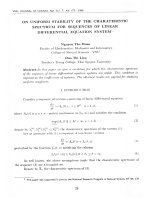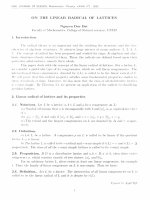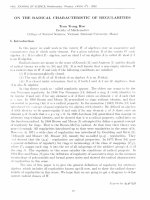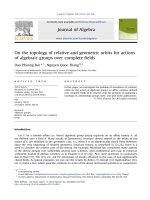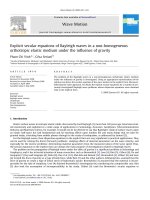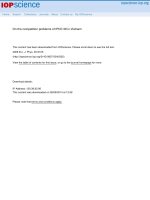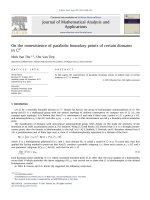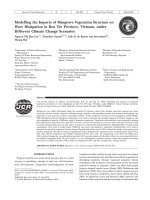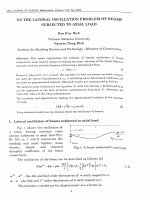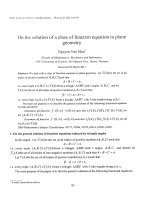DSpace at VNU: On the solution of a class of function equation in plane geometry
Bạn đang xem bản rút gọn của tài liệu. Xem và tải ngay bản đầy đủ của tài liệu tại đây (521.71 KB, 5 trang )
VNU Journal of Science, M athcrrnatics - Physics 27 (2011) 85-89
On the solution o f a class of function equation in plane
geometry
Nguyen Van Mau*
Faculty o f Mathematics, Mechanics and Informatics
VNU University o f Science, 334 Nguyen Trai, Hanoi, Vietnam
Received 30 March 2011
A bstract We deal with a class of function equation in plane geometry. Let I (A) be the set of all
triples of positive numbers {A , 5 , C ) such that
A-\-B c —7Ĩ^
i.e. every triple ( ^ , 5 , C ) e r ( A ) forms a ữiangle A /1 5 C with 3 angles A , B , C
let
r ( A ) be the set of all triples of positive numbers (ứf,ồ,c) such that
Ố -C
< a < ố + c,
i.e. every triple ( a , ố , c ) G r ( A ) forms a triangle A /45C with 3 side-Iengths being a , ^ , c :
■^rhe main our purpose is to describe ửie general solutions of the following functional equation
in plane geometry:
such that ( / ( y í ) , / ( ổ ) , / ( C ) ) G r(A) fo r
- Determine all function f : (0,oo) —>•
aỉỉ{A,B,C)^T{ầ)
*■Determine all function f : (0,co) —> (0,co) such that ( / (ữ ),/(ồ ),/(c)) e r(A) for all
2000 Mathermatics Subject Classification: 47J17, 47J06, 47J25, 65J14, 65J20, 65J05.
1. On the general solution o f function equations induced by triangle angles
In the sequel, Let r ( A ) be the set o f all triples o f positive numbers {A, B, C ) such that
-f 5 + c = 7T,
i.e. every triple ( y í , ổ , C ) G r(A) forms a triangle A ^ 5 C w i t h 3 angles A , B , C , and denote by
r ọ (A ) the set o f all triples o f non-negative numbers ( ^ , 5 , C ) such that^ + 5 + c = 7Ĩ.
Let r ( A ) b e the set o f all triples o f positive numbers ( a , ố , c ) such that
b-c\
The main purpose o f the paper is to find the general solutions o f the following functional equations.
* E-mail:
85
86
N.v. M au / VNU Jo u rn a l o f Science, M athem atics - Physics 27 (2011) 85-89
M ain problem 1. Determine all functions
f o r a ll
er(A ).
M ain problem 2.
/
(0,7t) such that { f { A ) , f { B ) , f { C ) ) e
: (0,7t) ^
Determine all functions /
: (0, oo) —> (0, oo) ( /
:
r(A)
E + ) such that
( / ( « ) , :{b), / ( c ) ) G F ( A ) for all (a, b, c) € F { A ) .
ĩirstìy we deal with continuous and differential solutions.
ProblcEi 1,1 Determine the general continuous solution
f{x) in [0,7t] and differentiabe in (0,7r) with
/ ( 0 ) = 0 such that i f (A), f { B ) , / ( C ) ) e r ( A ) for M { A , B , C ) e r ( A ) .
Solutioi.
We determine a diíĩerentiable function / ( x ) such that
f{x)>0,
V x e (0 ,7 r)
/(0 ) = 0
f{A) + f{B )+ f{C )= 7 T .
The assumption / ( 0 ) = 0 follows / ( t t ) = 7T and
That follows
c = 7T -
f { A) + f { B) + f { T ĩ - A -
{ A + B) .
^ A , B , A + B e [0, 7t]
hay
2
ỉ { x ) + f { y ) + f{Tĩ - X - y) = TĨ, V x , / , x + i / G [0,7t].
(1)
The denvative in X o f the both side o f (1) is given by
f { ^ ) - f '{ '^ - X - y )
V x , y , x + y G [0,7t].
(2)
Equalitj (8) follows that f ' { x ) is constant in ( 0 , 7r) and then f { x ) — p x + q. Since / ( 0 ) = 0 then
g = 0 aid f { x ) = px. Since / ( t t ) = 7T then p = I and we find f { x )
X.
Kence, only the function f{x) = X is a continuous in [0,7r] and differentiabe in(0, 7t )
with
/ ( 0 ) = 0 such that f { A ) , f { B ) , f { C ) form 3 angles o f a triangle for all given A A B C .
P r o b lc n 1.2. Determine all functions f { x ) defined in [0, 7t] such that i f { A) , f { B ) , f { C ) ) 6 r ( A )
for all given {A, D, C) E r ( A ) and / ( 0 ) = 0.
Soiutioi.
We formulate Problem 1.2 in the following equivalent form:
E-etermine the general solution in [0, 7t] o f the functional equation
+ f { y ) + / { t t - X - y) =
7T,
f { 0 ) = 0,
\ / x , y G {0, Tĩ ) , x + y < TT.
f{x)>0,
V x G (0 ,7 t).
Since / ( 0 ) = 0, from (3) w e get
/ ( x ) + / ( 0 ) + / ( tt - x) = 7T,
V x e [0 ,7 r\
Pating / ( x ) = X + g{x) then ổ(O) = 0 and
{3)
X + g{ x) + {tĩ - x) + g(7T — x) = 7T
g [ x ) + g{-K - x) - 0, Vx c [0 ,7T
( 3)
N.v. M au / VNU Journal o f Science, M alhem alics - P hysics 27 (2011) 85-89
87
or
(j{tĩ - x) = - f j { x ) , v.r e [0, n
Putting f { x )
X
+
M)
(j {x) to (3) and using (4), we find
+ V -I- iiiv) + 7T - (x + y) i- (]{n - {x -f y)) = 7T, Vx, y e [0,7r), X + y ^ 7T
or
f j {x + y)
(j{x) + g{ y ) , Vx', y G [ 0 , 7r], X + y iC 7T.
■J)
Hence i/(;r) is additive in [0,7t]. On the other hand, since f { x ) > 0 for all X e (0,7t), it follows
q{x) > - X > - 7T, i.e. g is bounded from the lower and then (J is linear (cf.[ 1]-[3]). Hence.
g { x ) = a x > - X for all X € (0,7t). It follows a > - 1 .
Hence, the general solution of the problem 1.2 is f { x ) ” (1 + n ) x , a > - 1 . Futhermore, by
the assumption, the equality f { A ) + f { D ) + f ( C ) - 7T follows 1 4- a — 1, i.e. a = 0 and f { x ) = X .
T h eo re m 1.1. All functions f { x ) defined in [0, 7t] such that i f {A) , f { B ) , / ( C ) ) € r ( A ) for all given
{ A J 3 , C ) e r ( A ) and ( / ( y l ) , / ( i i ) , / ( C ) ) G G o (A ) lor all given (y4,Z?,C) G G o(A ) are o f the
form / ( x ) = hx + ^ ( 1 - h), where
o
^
^ 6
1.
Proof. Note that two functions / ( x ) = X and /(.x) = ^ arc solutions.
We determine llie general solution /( :r ) in [0, 7t] with
ĩ { x ) + f { y ) + /(tt - X - y) = 7T,
Vx,y e [ 0 , 7r],x' + y ^ 7T.
/ ( x ) > 0,
(C)
Vx e (0, 7t)
l.et y = 0, then
/ ( x ) + / ( 0 ) + / ( tt - x) = 7T,
V x e [ 0 , 7T
or
/(tt - x)
7T - / ( 0 ) - / ( x ) ,
V x e [0, Tĩ'
Putting / ( tt — x ) = 7t — / ( 0 ) — / ( x ) into (6), we find
X + g [ x ) + y + g { y ) + 7T -
(x + y)
g { n - { x + y ) ) = 7T, V x ,y G [0, 7t], X + y ^ 7T
or
/ ( x + y) + / ( 0 ) = / ( x ) + / ( y ) , V x ,y € [0,7t] , x + ? / ^ 7T.
(7)
Putting / ( x ) = / ( 0 ) + g[ x) ^ 0. Then g[x) is additive in [0,7t] and (7) is of the form
g { x + y) = g{x) + g { y ) , Vx, y e [0, 7t], X-+ y ^ 7T.
(8)
Since g{ x) is additive
additive in [Q,7t] and g{x) ^^ //((00)) then
then (6)
(6) has
has the
the general
general solution
solution of
of the form
form / /((xx)) =—
bx + Ị3, where hx + (3 ^ Q for all X € [0, tt]. That follows / ( x ) is o f the form f { x ) =: ÒX + ^ ( 1 - 6),
3
88
N.v. M au / VNU Journal o f Science, M aihem aiics - Physics 27 (2 0 Ỉ Ỉ) 85-89
2. On the general solution o f functional equations induced by side lengths o f triangles
Let F ( A ) be the set of all triples of positive numbers (a, 6, c) such that
b - c\ < a < b
c,
i.e.every triple (a, 6, c) G F ( A ) forms a triangle / \ A D C with its side lengths being a, 6, c.
To determine the general solution f [ x ) in [0, 1] such that / ( a ) , /(fc), / ( c ) form 3 side lengths
of a triangle for all given Ò .A D C we need some additional discussions:
In the plane, consider the cirle o with diameter length 1 (unique circle). Denote by A /(A ) the set
o f all triangles inscribed in the cirle o . Note that, if / is a solution o f Problem 2 then F { x ) = Ằ /(x ).
with any A > Oj also satisfies Problem 2 and conversely. So it enough to exam ine the Problem 2 in
the case when the triples o f positive numbers (a ,6 , c) being the side lengths o f triangles in M ( A ) .
The sine theorem follows that a necessary and sufficient condition for three positive numbers
a , /3, 7 to be 3 angles o f a triangle in A /(A ) are sin a , sin/3, SÌ117 form 3 side lengths o f a triangle in
A /(A ).
Indeed, if a , /3,7 are 3 angles o f a triangle in A /(A ) then 2 R s i n a , 2/ỈSÍI1/9, 2 7 ? s in 7 or s i n a ,
sin/?, sin 7 are 3 side lengths o f a triangle inscribed in the cirle o with diameter
length 1.
Conversely, if sill tt, s i n /3, sill 7 are 3 side lengths o f a triangle inscribed in the cirle o with
diameter length 1 and a , p, 7 are positive then Q, /3, 7 form 3 angles o f a triangle.
Firstly, we formulate propositions for some simple specialized cases.
Proposition 2.1. The function f { x )
for all (a, Ò, c) € F ( A ) ift' a ^ 0.
X + a possesses the property that ( / ( a ) , f { b ) , / ( c ) ) 6 F { A )
Proposition 2.2. The function f { x )
a x possesses the property that / ( a ) ,
o f a triangle for all (a, Ò, c) e F { A ) iff Q > 0.
are side lengths
Proposition 2.3. The function f { x ) = a x + p possesses the property that / ( a ) , f { b ) , f { c ) are side
lengths o f a triangle for all (a, b, c) e F { A ) iff a ^ 0, p ĩi 0 and a + p > 0.
The function / ( x ) = ---- — r possesses the property that / ( a ) , f { b) , f { c ) are side
QX + p
lengths o f a triangle for all (a, b, c) E F { A ) iff Q = 0, p > 0.
Proposition 2.4.
Now we deal with the set A i { A ) , i e.
diameter length 1.
Theorem 2.1.
Any function /
(a, b, c) e M ( A ) is o f the form
/ ( x ) = sin
the set o f all triangles inscribed in the cirle o with
: [0,1] ^
arcsi nx +
[0,1] such that { f { a ) , f { b ) , f { c ) ) e M { A ) for all
^
Of ^
1.
( 9)
N .\[ M au / i'NU Journal o f Science, M athem atics - Physics 27 (2011) 85-89
89
Proof. Note that, if a-,/i, 7 are 3 angles o f a triangle in A /( A ) then 2 /? sin Q , 2/?siu/3, 2 /? s i n 7 or
sin a , rni i i , sill 7 are 3 side lengths o f a triangle inscribed in the cirle o with diameter length 1.
Conversely, if sin a , s in /i, sin 7 are 3 side lengths o f a triangle inscribed in the cirle o with
diameter lengtli 1 and
arc positive then Q, /9, 7 form 3 angles o f a triangle.
On the other hand, by theorem th m l, all functions f { x ) defined in [0,7t] such that i f {A), f { B ) ,
/ ( C ) ) G r ( A ) for all given { A , D , C ) e r ( ^ ) and ( / ( / 1 ) , f { D ) , / ( C ) ) e G(,(A) for all given
[ A , D , C ) € G o (A ) are o f the form f { x ) = bx + ^ ( 1 - b), where - - ^ 6 ^ 1 .
Hence, ihc general solution is o f the form (10).
No w we formulate the main result.
TheoTcm 2.2.
Any function / : K+ ^
R + such that ( / ( a ) , / ( ^ ) , / ( c ) ) G F { A ) for all { u, b, c) e
/■"(A) is o f the form
f { x ) = 'iis iii ( r t a r c s i n { x | +
V
o
/
- 7: ^
z
a ^
1-
(1 ^))
Proof. Applying the above additional discussion and tlieorem , it is easy to obtain the form (10).
R e m a r k 1. Some other types o f functional equations in geometry were considered firstly by s, Galab
[4].
4
References
[ 1 1 T. A c/.e'l, L e c tu r e s on J u n c tio n a l e q u a tio n s a n d th e ir a p p lic a tio n s. A c a d c m ic Press, N ew Yorkysan lTancisco/Londt>n,
m l 966.
[2] M. K.uc/.ina, B. C h o c z e w s k i, R. Gcr. ỉn te ra tiv e h u n c tio n a l E q u a tio n s, C a m b rid g e U niversity Press, CLiinbridgc/Ncw
York/Port C h c slc r /M e lb o u m e /S y d n c y , Í990.
[3] l^K. S ah oo , T. RicdcL M e a n Value T h eo rem s a n d F u n c tio n a l liq u a tio n s,
World Scienlific, Singapore/N cvv Jcr-
s e y /L o n d o n /IIo n g K o n g , 1998.
[4] S. G alab , F u n clio n c d e q iia iio n s in g eo m etry, Prace MaL, N o C C X X I I l, Z c s /y l 14, 1969.
